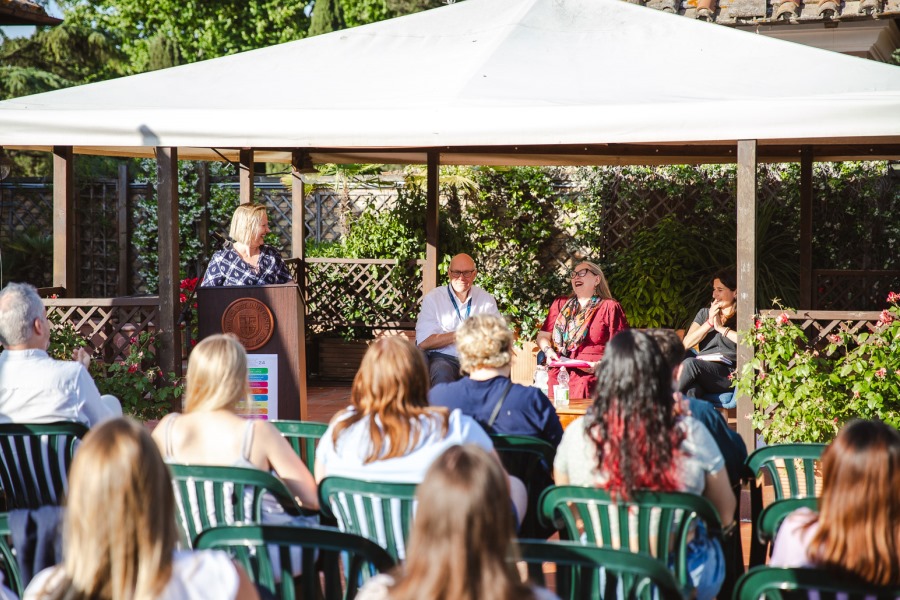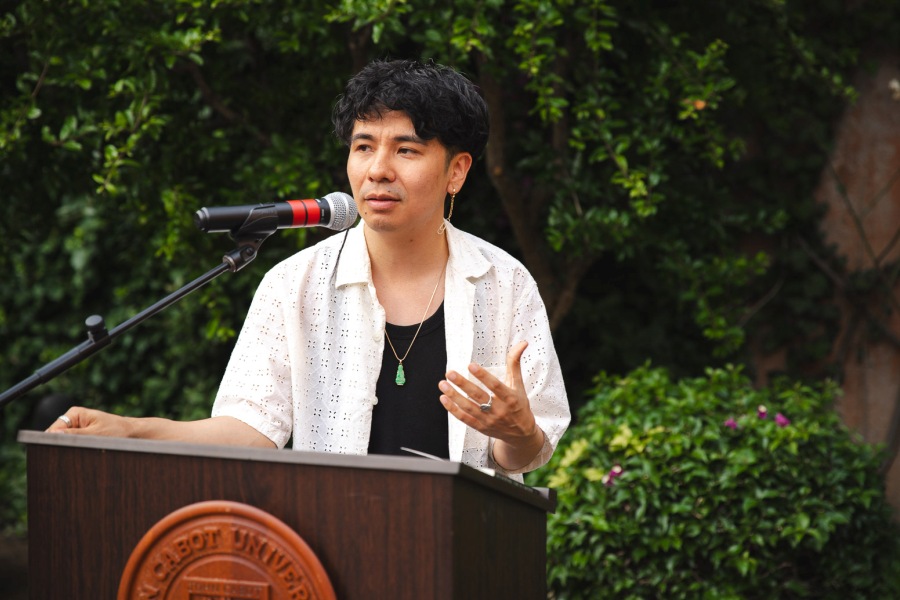Gender & Sexuality in the Digital Age: A Conversation With Artist Shu Lea Cheang
John Cabot University welcomed artist Shu Lea Cheang for a talk called The Algorithm of Gender & Sexuality in the Digital Age on November 26, 2019. The talk was organized by the JCU Communications Department as part of the Digital Delights and Disturbances Lecture Series. Cheang represented Taiwan at the 2019 Venice Biennale, where she exhibited her work called 3X3X6, an immersive installation that focused on imprisonment for sexual crimes, curated by philosopher Paul B. Preciado.
The Palazzo delle Prigioni, a Venetian prison from the sixteenth century where the Taiwan pavilion was located, inspired Cheang to research 10 historical and contemporary cases of prisoners incarcerated for sexual misconduct. The name 3X3X6 refers to a nine square-meter cell constantly monitored by six surveillance cameras, or as the artist put it, “today’s standardized architecture of industrial imprisonment.”
“Digital Panopticon”
Cheang’s work reflects on the transformation of surveillance techniques since the 18th century, through research on the human body and gender politics. The artist started from English philosopher Jeremy Bentham’s idea of Panopticon (1791), a concept for a circular prison with a central tower that allowed a single guard to observe all inmates. Prisoners would not able to tell whether or not they were being watched, so they would act as though they were being observed at all times. According to Cheang, nowadays we have a “digital Panopticon”, which observes us and our data.
In order to recreate the concept of the Panopticon, Cheang arranged, in Room A of the exhibition, a 3.5-meter surveillance tower that projected the portraits of the 10 cases she researched, played by actors. A 3D camera surveillance system scanned visitors’ faces and a Wi-Fi network allowed them to upload selfies and videos to an app that modified them and incorporated them in the exhibition. Rooms B and C of the exhibition featured 10 monitors placed on the floor, which showed the short films, produced by Cheang, each telling a prisoner’s story in about ten minutes. Room D allowed visitors to discover the control room and the operating system of the surveillance apparatus, or what Cheang calls “the cube,” a transparent box placed on the floor at a 30 degrees angle.
10 Cases
Cheang explained that she selected the 10 cases, both historical and contemporary, based on the geographical area, in order to have a more evenly distributed representation. The reason why the names are followed by an X is to symbolize that the crimes for which they were arrested don’t represent a single occurrence.
The first case that Cheang investigated was Italian author Giacomo Casanova X (1725-1798), who was imprisoned in the Palazzo delle Prigioni in Venice 1755 for reasons that are not very clear. According to Cheang, possible reasons for Casanova’s arrest could be a combination of corruption, indecency, and public outrage.
The Marquis de Sade X, who was imprisoned in the late 18th century in various French prisons for over 32 years of his life with charges of sexual abuse, deviance, sodomy, and blasphemy, was the second case investigated by Cheang.
The third case was French philosopher Michel Foucault X, who was investigated for homosexuality by the Polish police in 1959 and imprisoned for an unknown period of time.
The remaining seven cases investigate contemporary instances of imprisonment.
BX was a woman who was sentenced to life in prison in 2013 for cutting her husband’s penis and throwing it into a garbage disposal unit.
MWX was a man who, in 2006, signed a contract with another man he met in an internet cannibal cafe. The man agreed to be slaughtered and eaten after sex by MWX, who was then convicted of murder and sentenced to life imprisonment.
00X was a gay teacher from Taiwan who was arrested for engaging in unprotected sex and then sentenced to twelve years in prison for knowingly spreading the HIV virus.
DX was a transgender person who was sentenced to six years in the 2010s for having sex with a woman without revealing his gender status, or what is called “rape by deception.”
RX was a Muslim scholar arrested for alleged sexual assault and rape in 2018. He was detained for ten months in a prison near Paris.
LX was a Chinese woman who was charged with manufacturing and disseminating obscene articles on social media for profit in 2016. She was sentenced to four years in prison.
FSBX (Female Sperm Bandits) were three women imprisoned in Zimbabwe in 2011 for allegedly raping, harvesting, and selling men’s semen. Other similar cases have been recently reported in Zimbabwe and South Africa.
About the artist
Shu Lea Cheang is a multimedia artist who works in the fields of net-based installation, social interface and film production. Her work is often interactive, and she is known for her individual approach in the realm of art and technology, creatively combining social issues with artistic methods. After 20 years in New York, she went on a decade of a self-imposed lifestyle as a digital nomad. She lived in Japan, Holland, the United Kingdom, and Paris, where she has worked and resided since 2007.






